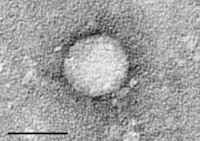
Photo from wikipedia
BACKGROUND The year 2020 in the extent of HCV infection was set for the first milestones on the road to the eradication of HCV infection in 2030. In addition, in… Click to show full abstract
BACKGROUND The year 2020 in the extent of HCV infection was set for the first milestones on the road to the eradication of HCV infection in 2030. In addition, in 2020 there was a global public health crisis - the COVID-19 pandemic. The aim of this paper was to assess the epidemiological situation of HCV infection based on epidemiological surveillance data in Poland in 2020. MATERIAL AND METHODS Analysis of: 1) individual data from surveillance in 2020 conducted by EpiBaza system; 2) diagnosis rate from bulletins "Infectious diseases and poisonings in Poland" for the years 2014-2020; and 3) data about deaths due to hepatitis C from the Demographic Surveys and Labour Market Department of Statistics Poland. RESULTS In 2020, there was a significant decrease in the number of reported cases and thus in the diagnosis rate of HCV infection in Poland - 955 HCV infections were reported (2.49/100,000 - in comparison with 2019, 3.5 times less). The decrease occurred in all voivodeships (ranging from 0.50 to 6.37/100,000), we observe more districts in which HCV infections were not detected (in 2020 - 35.3%; in 2019 - 16.8%). The diagnosis rate of HCV infection in women and men was at a similar level. However, large disproportions are visible if age groups are considered in addition to gender. For years, we have observed a variation of the diagnosis rate of HCV infection depending on the environment of residence - also in 2020, higher values were reported overall in residents of urban than in rural areas (2.90 vs. 1.88/100,000). In 2.9% of newly diagnosed HCV infections, at the same time cirrhosis was already present, 0.4% had liver failure, and 0.1% had hepatocellular carcinoma. Among exposures of HCV infection, those related to nosocomial transmission still dominate (59%), also in acute hepatitis C (60%). One-third of reported infections were diagnosed in primary health care, and one in four were diagnosed during hospitalization. CONCLUSIONS The data presented in this paper show that the COVID-19 pandemic deepened the inequalities observed for years in HCV areas. Establishing a diverse system of testing and linking to care in Poland, reaching those in the greatest risk of ongoing transmission of HCV infection, and providing methodologically correct studies to assess progress in the eradication of HCV infection is becoming increasingly urgent to achieve the planned 2030 WHO targets.
Journal Title: Przeglad epidemiologiczny
Year Published: 2022
Link to full text (if available)
Share on Social Media: Sign Up to like & get
recommendations!